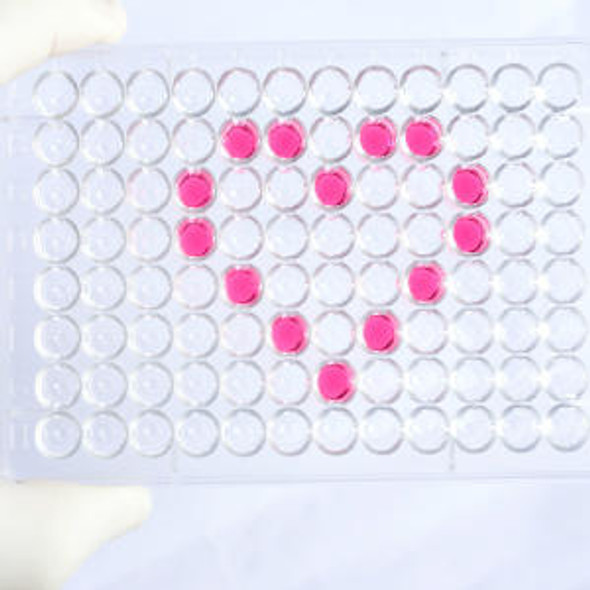Human Cell Biology ELISA Kits 1
Human FBN1 (Fibrillin 1) ELISA Kit (HUES03150)
- SKU:
- HUES03150
- Product Type:
- ELISA Kit
- Size:
- 96 Assays
- Uniprot:
- P35555
- Sensitivity:
- 0.19ng/mL
- Range:
- 0.31-20ng/mL
- ELISA Type:
- Sandwich
- Synonyms:
- FBN1, ACMICD, ECTOL1, FBN, GPHYSD2, MASS, MFS1, OCTD, SGS, SSKS, WMS, WMS2
- Reactivity:
- Human
- Sample Type:
- Serum, plasma and other biological fluids
- Research Area:
- Cell Biology
Description
| Assay type: | Sandwich |
| Format: | 96T |
| Assay time: | 4.5h |
| Reactivity: | Human |
| Detection Method: | Colormetric |
| Detection Range: | 0.31-20 ng/mL |
| Sensitivity: | 0.19 ng/mL |
| Sample Volume Required Per Well: | 100µL |
| Sample Type: | Serum, plasma and other biological fluids |
| Specificity: | This kit recognizes Human FBN1 in samples. No significant cross-reactivity or interference between Human FBN1 and analogues was observed. |
This ELISA kit uses Sandwich-ELISA as the method. The micro ELISA plate provided in this kit has been pre-coated with an antibody specific to Human FBN1. Standards or samples are added to the appropriate micro ELISA plate wells and combined with the specific antibody. Then a biotinylated detection antibody specific for Human FBN1 and Avidin-Horseradish Peroxidase (HRP) conjugate are added to each micro plate well successively and incubated. Free components are washed away. The substrate solution is added to each well. Only those wells that contain Human FBN1, biotinylated detection antibody and Avidin-HRP conjugate will appear blue in color. The enzyme-substrate reaction is terminated by adding Stop Solution and the color turns yellow. The optical density (OD) is measured spectrophotometrically at a wavelength of 450 nm ± 2 nm. The OD value is proportional to the concentration of Human FBN1. The concentration of Human FBN1 in samples can be calculated by comparing the OD of the samples to the standard curve.
| UniProt Protein Function: | FBN1: a structural component of the 10-12 nm diameter microfibrils of the extracellular matrix, which conveys both structural and regulatory properties to load-bearing connective tissues. FBN1-containing microfibrils provide long-term force bearing structural support. In tissues such as the lung, blood vessels and skin, microfibrils form the periphery of the elastic fiber, acting as a scaffold for the deposition of elastin. In addition, microfibrils can occur as elastin-independent networks in tissues such as the ciliary zonule, tendon, cornea and glomerulus where they provide tensile strength and have anchoring roles. Plays a key role in tissue homeostasis through specific interactions with growth factors, such as the bone morphogenetic proteins (BMPs), growth and differentiation factors and latent transforming growth factor-beta-binding proteins, cell-surface integrins and other extracellular matrix protein and proteoglycan components. Regulates osteoblast maturation by controlling TGF-beta bioavailability and calibrating TGF-beta and BMP levels, respectively. Negatively regulates osteoclastogenesis by binding and sequestering an osteoclast differentiation and activation factor TNFSF11. This leads to disruption of TNFSF11-induced Ca2+ signaling and impairment of TNFSF11-mediated nuclear translocation and activation of transcription factor NFATC1 which regulates genes important for osteoclast differentiation and function. Mediates cell adhesion via its binding to cell surface receptors integrins ITGB3 and ITGB1. Binds heparin and this interaction has an important role in the assembly of microfibrils. Cleavage of N- and C-termini is required for incorporation into the extracellular matrix and assembly into microfibrils. Its cleaved C-terminal peptide (2732 ¿ 2871) is the hormone asprosin, secreted by white adipose tissue that targets the liver, stimulating the release of glucose and increasing plasma glucose levels. Acts in response to fasting, and promotes hepathocyte glucose release via a PKA-dependent pathway. |
| UniProt Protein Details: | Protein type:Extracellular matrix; Secreted; Secreted, signal peptide Chromosomal Location of Human Ortholog: 15q21. 1 Cellular Component: basement membrane; extracellular matrix; extracellular region; extracellular space; microfibril; proteinaceous extracellular matrix Molecular Function:calcium ion binding; extracellular matrix constituent conferring elasticity; extracellular matrix structural constituent; heparin binding; integrin binding; protein binding; protein complex binding Biological Process: camera-type eye development; cell adhesion mediated by integrin; embryonic eye morphogenesis; extracellular matrix disassembly; extracellular matrix organization and biogenesis; heart development; negative regulation of osteoclast differentiation; post-embryonic eye morphogenesis; skeletal development Disease: Acromicric Dysplasia; Ectopia Lentis 1, Isolated, Autosomal Dominant; Geleophysic Dysplasia 2; Marfan Lipodystrophy Syndrome; Marfan Syndrome; Mass Syndrome; Stiff Skin Syndrome; Weill-marchesani Syndrome 2 |
| NCBI Summary: | This gene encodes a member of the fibrillin family of proteins. The encoded preproprotein is proteolytically processed to generate two proteins including the extracellular matrix component fibrillin-1 and the protein hormone asprosin. Fibrillin-1 is an extracellular matrix glycoprotein that serves as a structural component of calcium-binding microfibrils. These microfibrils provide force-bearing structural support in elastic and nonelastic connective tissue throughout the body. Asprosin, secreted by white adipose tissue, has been shown to regulate glucose homeostasis. Mutations in this gene are associated with Marfan syndrome and the related MASS phenotype, as well as ectopia lentis syndrome, Weill-Marchesani syndrome, Shprintzen-Goldberg syndrome and neonatal progeroid syndrome. [provided by RefSeq, Apr 2016] |
| UniProt Code: | P35555 |
| NCBI GenInfo Identifier: | 311033452 |
| NCBI Gene ID: | 2200 |
| NCBI Accession: | P35555. 3 |
| UniProt Secondary Accession: | P35555,Q15972, Q75N87, B2RUU0, D2JYH6, |
| UniProt Related Accession: | P35555 |
| Molecular Weight: | 312,237 Da |
| NCBI Full Name: | Fibrillin-1 |
| NCBI Synonym Full Names: | fibrillin 1 |
| NCBI Official Symbol: | FBN1 |
| NCBI Official Synonym Symbols: | FBN; SGS; WMS; MASS; MFLS; MFS1; OCTD; SSKS; WMS2; ACMICD; ECTOL1; GPHYSD2 |
| NCBI Protein Information: | fibrillin-1 |
| UniProt Protein Name: | Fibrillin-1 |
| Protein Family: | Fibrillin |
| UniProt Gene Name: | FBN1 |
As the OD values of the standard curve may vary according to the conditions of the actual assay performance (e. g. operator, pipetting technique, washing technique or temperature effects), the operator should establish a standard curve for each test. Typical standard curve and data is provided below for reference only.
| Concentration (ng/mL) | O.D | Average | Corrected |
| 20 | 2.27 2.292 | 2.281 | 2.218 |
| 10 | 1.561 1.603 | 1.582 | 1.519 |
| 5 | 0.916 0.91 | 0.913 | 0.85 |
| 2.5 | 0.456 0.464 | 0.46 | 0.397 |
| 1.25 | 0.249 0.243 | 0.246 | 0.183 |
| 0.63 | 0.162 0.156 | 0.159 | 0.096 |
| 0.31 | 0.111 0.113 | 0.112 | 0.049 |
| 0 | 0.061 0.065 | 0.063 | -- |
Precision
Intra-assay Precision (Precision within an assay): 3 samples with low, mid range and high level Human FBN1 were tested 20 times on one plate, respectively.
Inter-assay Precision (Precision between assays): 3 samples with low, mid range and high level Human FBN1 were tested on 3 different plates, 20 replicates in each plate.
| Intra-assay Precision | Inter-assay Precision | |||||
| Sample | 1 | 2 | 3 | 1 | 2 | 3 |
| n | 20 | 20 | 20 | 20 | 20 | 20 |
| Mean (ng/mL) | 1.05 | 1.86 | 7.70 | 1.03 | 2.01 | 8.45 |
| Standard deviation | 0.07 | 0.08 | 0.34 | 0.07 | 0.12 | 0.30 |
| C V (%) | 6.67 | 4.30 | 4.42 | 6.80 | 5.97 | 3.55 |
Recovery
The recovery of Human FBN1 spiked at three different levels in samples throughout the range of the assay was evaluated in various matrices.
| Sample Type | Range (%) | Average Recovery (%) |
| Serum (n=5) | 87-100 | 93 |
| EDTA plasma (n=5) | 89-103 | 96 |
| Cell culture media (n=5) | 90-104 | 95 |
Linearity
Samples were spiked with high concentrations of Human FBN1 and diluted with Reference Standard & Sample Diluent to produce samples with values within the range of the assay.
| Serum (n=5) | EDTA plasma (n=5) | Cell culture media (n=5) | ||
| 1:2 | Range (%) | 89-102 | 97-109 | 87-103 |
| Average (%) | 95 | 103 | 94 | |
| 1:4 | Range (%) | 94-106 | 81-93 | 84-97 |
| Average (%) | 100 | 86 | 89 | |
| 1:8 | Range (%) | 87-98 | 81-94 | 87-101 |
| Average (%) | 92 | 87 | 94 | |
| 1:16 | Range (%) | 86-99 | 79-89 | 82-95 |
| Average (%) | 92 | 85 | 87 |
An unopened kit can be stored at 4°C for 1 month. If the kit is not used within 1 month, store the items separately according to the following conditions once the kit is received.
| Item | Specifications | Storage |
| Micro ELISA Plate(Dismountable) | 8 wells ×12 strips | -20°C, 6 months |
| Reference Standard | 2 vials | |
| Concentrated Biotinylated Detection Ab (100×) | 1 vial, 120 µL | |
| Concentrated HRP Conjugate (100×) | 1 vial, 120 µL | -20°C(shading light), 6 months |
| Reference Standard & Sample Diluent | 1 vial, 20 mL | 4°C, 6 months |
| Biotinylated Detection Ab Diluent | 1 vial, 14 mL | |
| HRP Conjugate Diluent | 1 vial, 14 mL | |
| Concentrated Wash Buffer (25×) | 1 vial, 30 mL | |
| Substrate Reagent | 1 vial, 10 mL | 4°C(shading light) |
| Stop Solution | 1 vial, 10 mL | 4°C |
| Plate Sealer | 5 pieces | |
| Product Description | 1 copy | |
| Certificate of Analysis | 1 copy |
- Set standard, test sample and control (zero) wells on the pre-coated plate and record theirpositions. It is recommended to measure each standard and sample in duplicate. Note: addall solutions to the bottom of the plate wells while avoiding contact with the well walls. Ensuresolutions do not foam when adding to the wells.
- Aliquot 100µl of standard solutions into the standard wells.
- Add 100µl of Sample / Standard dilution buffer into the control (zero) well.
- Add 100µl of properly diluted sample (serum, plasma, tissue homogenates and otherbiological fluids) into test sample wells.
- Cover the plate with the sealer provided in the kit and incubate for 90 min at 37°C.
- Aspirate the liquid from each well, do not wash. Immediately add 100µL of BiotinylatedDetection Ab working solution to each well. Cover the plate with a plate seal and gently mix. Incubate for 1 hour at 37°C.
- Aspirate or decant the solution from the plate and add 350µL of wash buffer to each welland incubate for 1-2 minutes at room temperature. Aspirate the solution from each well andclap the plate on absorbent filter paper to dry. Repeat this process 3 times. Note: a microplatewasher can be used in this step and other wash steps.
- Add 100µL of HRP Conjugate working solution to each well. Cover with a plate seal andincubate for 30 min at 37°C.
- Aspirate or decant the solution from each well. Repeat the wash process for five times asconducted in step 7.
- Add 90µL of Substrate Reagent to each well. Cover with a new plate seal and incubate forapproximately 15 min at 37°C. Protect the plate from light. Note: the reaction time can beshortened or extended according to the actual color change, but not by more than 30min.
- Add 50 µL of Stop Solution to each well. Note: Adding the stop solution should be done inthe same order as the substrate solution.
- Determine the optical density (OD value) of each well immediately with a microplate readerset at 450 nm.






